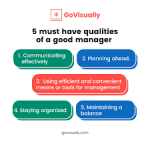Motivate your group members.
How do you raise your group members' motivation levels? The very first step is to affirm that there's clarity regarding every worker's role. Each individual needs to have a very clear set of aims and a comprehension of how to attain them.
If the air at work is favorable, everybody will put in her or his very best to get the targets. If the office is pervaded by a pessimistic and gloomy mood, you can make certain morale and productivity will be reduced.
Providing the tools and facilities to aid in achieving all these defining targets, and tracking the landmarks along the way may be the very best way.
Handing over a list of duties is insufficient. As a supervisor, you listen to their own opinions and opinions and must speak to every worker.
Have Restraint
A desirable result isn't achieved, or if there is a job treated incorrectly, you need to give a chance to the individual. This provides you with the opportunity to avoid a recurrence of the matter to offer opinions and, in most probability.
If you're guilty of following this practice (or some variant ), stop instantly. You'll need to compete with workers who will depart from your business, Should you continue.
In the event that you were a worker, would you wish to work in a location where the boss has something nasty to say for everybody and is prepared to fly off the handle at the slightest provocation? You do not need to worry and cause yourself more stress, in fact one of the main inducers of stress is uncertainty for your safety, Click here to avoid this problem in the work space. Or do you prefer a supervisor who listens to the topics that you raise and provides advice and support?
The pressure level on the job can become just. In such scenarios supervisors vent their frustration. That can be delivered in the existence of co-workers, and in a tone that is unpleasant.
Your group members will greatly appreciate Just a little patience on your part. An extra advantage is that they are most likely to put that next time.
Hold your group members accountable.
As a supervisor, one of the functions is to maintain employees accountable for the tasks. Among the most effective ways to do so is to measure results. Should you just happen to be carrying a revenue inspection for the quarter, ensure the information you're currently using is right and available for your group members. Should you utilize information that is unreliable, the assembly won't serve any function.
When you delegate a group member a task, take action as definitely as you can. What if the result be? When would you want the job? Very deadlines are missed since the communication was obscure or not hauled in a proper method. You might have assigned parts of work rather than explained that was carried out .
Holding employees will reveal that you're seriously interested in achieving outcomes. Importance will be given by your staff members to the activities they are allocated to you.

